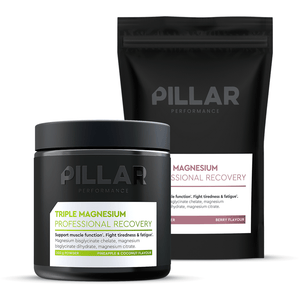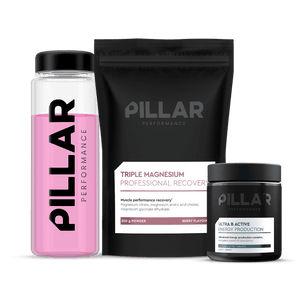It’s your choice - with our knowledge.

Product Insights
Discover more about the products in this article

Triple Magnesium
Featured Products
Browse the full range from PILLAR Performance
Magnesium: The Unsung Hero of Athletic Recovery
Magnesium stands as one of the most abundant minerals, playing a pivotal role in over three hundred biochemical processes within the body. These processes encompass a wide range of functions, from facilitating a restful night's sleep to contributing to the synthesis of DNA.
For athletes, magnesium holds particular significance due to its involvement in glycolysis and creatine phosphate production.
In simpler terms, this translates to the generation of energy for muscles during physical exertion and sustaining overall endurance.
Diets rich in seeds, nuts, dark leafy greens, legumes, and select carbohydrates like oats and wheat provide excellent dietary sources of magnesium. However, magnesium deficiency remains a common issue, with conservative estimates suggesting that approximately one-third of individuals are affected. Several factors can contribute to this deficiency, including poor diet quality, excessive dietary fat intake (which can hinder magnesium absorption), digestive disorders like Crohn's disease, and rigorous exercise routines.
Yes, you read it correctly - exercise itself can deplete magnesium levels through sweat, urine, and alterations in blood levels resulting from intense physical activity. This means that athletes require higher daily magnesium intake than sedentary individuals. Moreover, athletes following restrictive diets may be at an elevated risk of magnesium deficiency.
Why is this important?
Optimal athletic performance hinges on an athlete's ability to train at peak performance levels for extended durations.
While much of the focus on supplementation revolves around performance enhancement, post-performance care is equally crucial to ensure that individuals recover effectively and do not deplete their resources.
Given that magnesium plays a central role in neuromuscular transmission and muscle contraction, magnesium deficiency can predispose individuals to muscle cramps and nocturnal spasms, disrupting sleep quality and overall recovery.
A study by Roffe et al. (2002) found that magnesium supplementation may effectively treat cramps, with individuals reporting a reduction in leg cramp occurrences compared to the placebo group.
Magnesium is also essential for bone growth and maintaining bone density, with magnesium deficiency linked to an increased risk of osteoporosis. This is unsurprising, considering that roughly 57% of the body's magnesium resides in our bones. Alleviating discomfort, cramps, and pain ensures that athletes receive both mental and physical support, ultimately leading to improved short- and long-term outcomes. Enhanced recovery aids athletes in consistently performing at their peak.
So, if you've decided to incorporate magnesium supplementation into your routine...
Given the plethora of magnesium supplements available on the market, selecting the most suitable one can be a challenging task. While price often influences decisions, the most critical aspect to consider when choosing a magnesium supplement is not its cost or magnesium content, but its form.
This is because not all magnesium forms are created equal. Different preparations of magnesium possess unique properties and chemical structures that impact their solubility and, consequently, their bioavailability. Below are some common forms:
- Magnesium Citrate: As the name suggests, magnesium citrate is magnesium bound to citrate. Citrate is a large molecule that is readily absorbed into the gastrointestinal tract, where it dissociates, allowing for efficient magnesium absorption into the bloodstream. Its exceptional bioavailability and solubility make it an excellent choice for supplementation.
- Magnesium Amino Acid Chelate: Chelated magnesium has a high bioavailability as magnesium is bound to various amino acids. Although it is costly to produce, chelated magnesium is favoured because it can reach parts of the body that other forms cannot access due to the absence of an amino acid binding complex. Magnesium amino acid chelates offer various benefits, including increased energy levels, improved mood, cognition, and cardiovascular health.
- Magnesium Glycinate: Similar to chelated magnesium, magnesium glycinate features magnesium bound to the amino acid glycine. It is considered one of the more easily tolerated and gentle formulations, offering high bioavailability. It is typically well absorbed in the gastrointestinal tract and is often associated with the calming effects often observed with magnesium supplementation. It works synergistically with neurotransmitters like GABA to promote relaxation and alleviate sleep disturbances.
- Magnesium Oxide: Magnesium oxide is an inorganic magnesium salt, making it one of the least absorbable forms available. While it provides a greater amount of magnesium per dose due to its small molecule size, it is slowly absorbed in the gastrointestinal tract and can lead to a strong and often unwanted laxative effect due to its hydrophilic properties in the colon.
Supplementing with multiple forms of magnesium individually can be costly and uncomfortable due to the generally unpalatable nature of tablets and capsules. Therefore, opting for a single formulation that combines multiple highly bioavailable magnesium forms is ideal. Remember, more is not always better. Always scrutinize ingredient labels to ensure quality magnesium forms are used, with magnesium citrate, magnesium glycinate, and magnesium chelate being the most common options. This approach will save you from unnecessary expenses, subpar results, and gastrointestinal discomfort.
PILLAR's Triple Magnesium formulation combines these three scientifically proven magnesium forms to maximize results. These forms have been specifically chosen for their exceptional bioavailability, well-established tolerance, and ability to work synergistically to offer a broad range of benefits, from mood enhancement to muscle recovery.
In addition to its star ingredient (magnesium), Triple Magnesium also incorporates essential minerals like potassium and calcium to provide comprehensive support for neuromuscular and cardiovascular functions, as well as energy production. From dosage to formulation, all components of our Triple Magnesium are clinically validated to deliver multifaceted support for neuromuscular function and recovery in the convenient form of a single film-coated tablet or powder.
Get started today with the Pillar Recovery Starter pack from XMiles.
References:
- Abbasi, B., Kimiagar, M., Sadeghniiat, K., Shirazi, M. M., Hedayati, M., & Rashidkhani, B. (2012). The effect of magnesium supplementation on primary insomnia in the elderly: A double-blind placebo-controlled clinical trial. Journal of research in medical sciences: the official journal of Isfahan University of Medical Sciences, 17(12), 1161–1169.
- Musso C, G. (2009) Magnesium metabolism in health and disease. International Journal of Urology and Nephrology. 41(2), 357-362
- Rayssiguier Y., Guezennec C.Y., Durlach J. (1990). New experimental and clinical data on the relationship between magnesium and sport. Magnesium Research 3, 93-102
- Kass, L. S., Skinner, P., & Poeira, F. (2013). A pilot study on the effects of magnesium supplementation with high and low habitual dietary magnesium intake on resting and recovery from aerobic and resistance exercise and systolic blood pressure. Journal of sports science & medicine, 12(1), 144–150.
- 'Magnesium Comes In Many Different Forms – Which Types Do You Need?' (2020) About Health New Zealand. Available at: https://www.abouthealth.co.nz/
- Lindberg, J. S., Zobitz, M. M., Poindexter, J. R., & Pak, C. Y. (1990). Magnesium bioavailability from magnesium citrate and magnesium oxide. Journal of the American College of Nutrition, 9(1), 48–55.
- https://doi.org/10.1080/07315724.1990.10720349 Ates, M., Kizild
It’s your choice - with our knowledge.









































































































